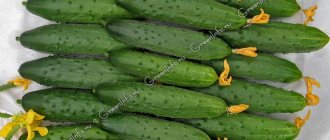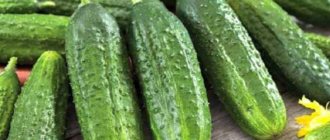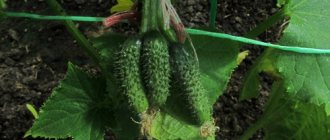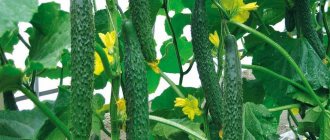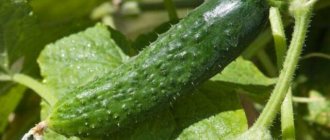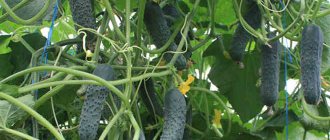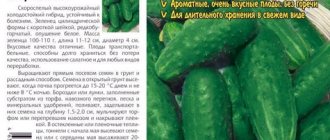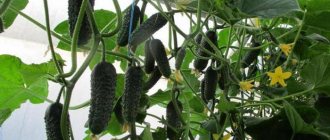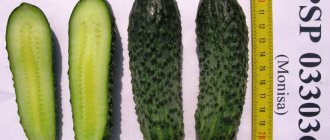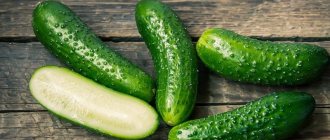The Beijing gourmet cucumber f1 has an original appearance. It will come in handy for feasts or for everyday lunches, and will enhance the taste of fresh salads. Like all Chinese cucumbers, it is very long and thin, so it is not suitable for canning.
| Landing location | Ripening time | Mode of application | Fruit length | Group | Fruit smoothness | Pollination method |
| Universal | Early ripening (35-45 days) | Salad | Very long - more than 20 cm | Hybrid | Highly lumpy | Parthenocarpic |
Features and description of culture
Cucumber from China is interesting in every way. Its name suggests that it belongs to the genus of cucumbers, but has some differences in subspecies characteristics:
- Long-fruited vegetable. Each cucumber is huge in size. The length ranges from 50-80 centimeters. If a giant is grown on a trellis, tied up in a greenhouse, then it is no wonder to grow a longer specimen, since in this regard its possibilities are limitless.
- The taste of cucumbers differs significantly from usual vegetables. It has no bitterness, and the flesh is sweetish.
- Does not form voids and does not become rough during ripening.
Externally, the cucumber is also unforgettable. The color is rich green, usually dark tones. There are prickly “pimples” on the peel; there are varieties that are not prickly, with a smooth surface. The developed hybrids are distinguished by early ripening and abundant fruiting. The first harvest is harvested a month after germination, which is approximately 35-40 days.
Advantages and disadvantages
Cucumbers are grown in any conditions: in greenhouses, greenhouses, and outdoor beds. When breeding varieties of Chinese cucumbers, all the disadvantages of simple vegetables were taken into account:
- high resistance to diseases;
- low light requirement, cucumber can grow in partial shade;
- absence of barren flowers;
- abundant fruiting, up to 30 kg per bush with proper agricultural technology;
- use part, that is, cut off half of the cucumber directly at the root, after a while it grows back;
- good presentation even in an overripe state, the cucumber does not swell, does not turn yellow, does not become empty;
- All available varieties are cold-resistant and hardy in hot conditions.
But even with the existing advantages, there are still nuances that breeders still need to work on:
- cucumber has a short shelf life, which is why it is not used for transportation over long distances;
- many varieties of Chinese cucumbers are covered with an abundance of sharp, scratching thorns;
- used for fresh consumption, less often for pickling;
- require vertical cultivation, otherwise you will end up with ugly, bent cucumbers.
To all this, it should be added that many summer residents note the poor germination of Chinese cucumber seeds.
Where is it recommended to grow the crop?
Cucumber culture loves vertical placement. If it is possible to ensure such cultivation in open ground, then it is worth taking advantage of it; if not, then it is better to grow it in a greenhouse. To get an early harvest of vegetables, it is recommended to place the Chinese in a greenhouse. In this case, you get absolutely smooth, long cucumbers.
Many gardeners, due to their capabilities, grow giant cucumbers on the street. The beds are placed directly on the soil. Then the cucumbers will have a bizarre shape, but the taste will not deteriorate.
Greenhouse maintenance allows you to provide the plant with more optimal growing conditions than in open ground.
Unstable weather, hot day and cold night, frequent incessant rains, all this will negatively affect the flowering, ovary and ripening of cucumbers. Therefore, the best option is a greenhouse with a polycarbonate or glass covering. If one is not available, cucumbers can be placed in a greenhouse, but the size of the greenhouse does not allow growing vegetables vertically.
Description and characteristics of the variety
Beijing gourmet f1 cucumbers have tall, powerful bushes with large leaves. Despite its size, it can be grown not only in open ground or in greenhouses, but also on loggias and balconies, if you choose a large enough container (at least 8 liters of soil). The flowers set fruit on their own and do not require pollination. Description and characteristics of the fruits: ripen 44-47 days after the sprouts appear. Their length reaches 33-35 cm, sometimes cucumbers can bend, usually due to improper watering. The skin is dark green, covered with large tubercles, the color of the spines is white. The seed chambers are small and the seeds do not ripen. The pulp is sweetish, aromatic, very tasty. Mainly used in salads.
Features of planting cucumbers
Growing vegetable giants is not difficult. The agricultural technology is identical to the algorithm for planting and caring for ordinary cucumbers. What needs to be done to get early and tasty green “snakes”.
Deciding on the variety and preparing the seeds
Before going to the store, it is better to immediately decide on the variety so as not to waste your time reading all the descriptions on the bags. It is important to carefully select a variety that will meet all growing conditions in a particular region.
It is enough to purchase 1-2 bags, since the cucumber gives a bountiful harvest, and just a few vines will provide seven crunchy vegetables. Some varieties are not suitable for pickling at all, so you should not replace your usual and favorite types of pickling cucumbers with Chinese ones.
Seeds need to be prepared for planting. This means soaking in water for germination. After a few days, the seed shells will hatch and you can begin planting seedlings or in a hole in outdoor beds.
Soil preparation
When growing cucumbers in a greenhouse, soil preparation is carried out in the fall. In greenhouse beds, two parts of sawdust, turf and 4 parts of humus are added to the soil. This substrate should be saturated with fertilizers, which consist of 10 liters of water with the addition of:
- saltpeter - 20 grams;
- wood ash - 250 grams;
- potassium magnesia - 15 grams;
- double superphosphate - 40 grams;
- urea - 10 grams.
With this autumn feeding of cucumbers, there is no need to fertilize the plants during the next growing season.
For open ground, it is not enough to simply dig a bed. You will also have to work hard here. Humus is mixed with straw and mixed with soil on the ridge. Spray thoroughly with water and cover with polyethylene. After a week, they begin sowing seeds.
Sowing seeds and germinating seedlings
It is quite easy to sow seeds in outdoor garden beds. Typically, a cucumber bed is made in the form of a trench with a furrow in the middle. Holes are made in this furrow at a distance of 20-25 cm, into which pre-sprouted seeds or germinated seedlings are placed. The earth is lightly patted with your hands and watered from a watering can.
There should be no other watering, as there is a risk of erosion of the soil and washing of seeds to the surface. The beds can be sprinkled with mulch.
The greenhouse will require seedlings. To grow it, they usually take cups with a diameter of up to 12 cm. It is better if they are peat. When planting later, the roots are not injured, since the cups are completely buried in the ground.
See also
How to make a cucumber bed in open ground with your own hands, types
Read
Seedlings are grown in the following way:
- The seeds are pickled in a solution of potassium permanganate and then dried.
- Fertile soil is poured into each cup, taken from a bed with prepared soil. Two seeds are planted in the ground in case one of them does not sprout. Planting depth 1 cm.
- The soil is well watered and covered with film. It is important to place the cups in a room where the temperature is about 30 degrees.
- After the cucumber shoots appear, the film is removed. The seedlings are watered and sprayed; they do not require any other care.
- If two cucumbers have grown in a pot, on the 15th day after emergence, one is removed, the flimsiest one.
- Cucumber seedlings are planted in a greenhouse from the 15th to the 30th day of growth.
It should be remembered that when calculating the distance between seedlings, it should be taken into account that the Chinese cucumber grows almost as one vine and produces little lateral growth. Therefore, it is enough to leave 20-30 cm between neighbors.
Timing for planting plants in the ground
Cucumber seeds are planted in open ground from May 1 to May 10, if the soil is warm enough and at night the temperature does not drop below +15 degrees. Otherwise, the deadlines will be shifted. These periods are different in different regions of Russia, so it is important to take into account climatic conditions.
It is always warm in the greenhouse, so the last ten days of April or the first days of May are suitable times for any region.
Even in rainy and cloudy weather it is always warm under the shelter. It is important to install a thermometer to monitor the temperature at the top of the greenhouse and in the soil. If the temperature drops, then special heating lamps are installed.
Landing Features
Cucumber as a crop originated in distant India, where there are no strong winds, fertile soils and a warm climate. Of course, modern hybrid varieties differ from their ancient predecessors, but the Beijing Gourmet f1 variety still requires planting features and good care.
Preparing the soil and site for planting
Although almost all gardeners and summer residents plant cucumbers, not everyone gets a good and high-quality harvest. Beijing Gourmand cucumber f1 should be planted in elevated areas where there are no strong drafts. The soil should be loamy, sandy loam or black earth. Despite the fact that cucumber is a moisture-loving crop, the soil should be moderately moist. To prevent water from retaining, you need to constantly loosen the soil.
Before planting the Beijing Gourmet variety, be sure to feed the soil. It’s better to start in the fall, but you can also start in the early spring. It is imperative to remove unnecessary remains of leaves and plants. To feed during digging, you can add manure, chicken droppings or other organic matter.
Advice! In order for the earth to warm up faster, at the beginning of spring, place non-woven material on the future site of planting the cucumber.
How to properly germinate seeds of long-fruited cucumbers
Germination of seeds is the most important and necessary stage when growing Beijing Gourmet cucumber. To do this, you need to prepare a saline solution, potassium permanganate or aloe juice, a cotton cloth, a plate, a jar. Follow the algorithm:
- Soak the seeds of the Beijing Gourmet variety in a saline solution. We germinate those that have sunk to the bottom, and throw out the rest.
- Dip the seeds in a solution of potassium permanganate or aloe juice to neutralize them for 15 minutes (it helps well against diseases and pests).
- Roll up a cloth, put a Peking Gourmet cucumber seed inside, moisten it and place on a plate.
- Leave in a warm place, if desired. Cover with a glass jar.
- Wait 2-3 days.
Growing seedlings
The Beijing Gourmet variety should be planted in late March - early April. For seedlings you need to purchase peat or plastic cups. You can prepare the planting mixture yourself: mix humus and soil in equal proportions in a bucket, add 2 liters of washed sand + 0.5 liters of ash + a spoonful of superphosphate. Mix all this and fill the pots. You can buy a ready-made mixture.
Dry the seeds of the Beijing Gourmet cucumber and plant them to a depth of 2-3 cm. Be sure to water and feed after the first leaf appears. The room temperature should be 22-25°C. Humidify the air, especially during the heating season.
Rules for caring for Chinese bushes
Usually the Chinese are planted together with other cucumbers. Somewhere on the side there are several lashes. Therefore, caring for Chinese cucumbers is carried out by analogy with simple ones.
Watering
When grown in a greenhouse, cucumber beds are watered generously twice a week, as moisture slowly evaporates from the surface of the soil, but leaves and stems are sprayed every day. Water is used that is settled, that is, with a temperature above 12 degrees.
In open ground, serpentine cucumbers are watered in the morning and evening in hot weather. On cloudy days, moisten as the soil dries. The sprinkling method is used. This type of watering involves providing plants with water from a watering can or hose with a sprayer.
Top dressing
If fertilizers have been applied to the garden bed since the fall, then this is no longer necessary. In the greenhouse, cucumbers are fed several times a season: two weeks after planting the seedlings in the soil, at the beginning of flowering and during the fruiting period. You can spray with a urea solution to increase yield.
You can use the “Chinese mixture”, that is, a self-prepared fertilizer that has a beneficial effect on growth, it is both a remedy against parasites and diseases and does not remain in cucumbers, and is safe for humans. Do it as follows:
- Mix the ingredients: 1 gram of boric acid, potassium permanganate, iron sulfate, 3 grams of copper sulfate, 100 grams of urea.
- First, urea is dissolved in water. Boric acid is diluted in a separate glass. Then pour urea into the resulting water, then add potassium permanganate and vitriol.
- Spray once every two weeks. You can pick it in a couple of days.
The same technique can be carried out on street beds. In the five-leaf phase, cucumbers are fed with fresh mullein infusion. The solution is prepared at the rate of 1 liter of mullein per 10 liters of warm water. The next feeding of cucumbers is carried out in two weeks. Chicken manure is used. Take 0.7 kg of litter per 10 liters of water. Water around the bush, avoiding contact with the plant.
When the cucumbers bloom, you can feed them with an aqueous solution of wood ash at the rate of 1 cup of ash per bucket of water. At the end of fruiting, they are fed with the same chicken droppings or complex mineral fertilizers.
Formation of the lash
As the cucumber greens grow, trellises are installed in the open ground and a net is stretched or ropes are pulled. A vertical support is made in the greenhouse, to which the central shoot will subsequently be tied.
When the main stem is formed, side shoots emerge from it. Starting from the root, count five shoots, which should be plucked or cut very carefully so as not to damage the plant and root.
Loosening and mulching the soil
The root system of cucumbers loves loose, airy soil, so when removing weeds, use a hoe to loosen it slightly. Since the roots of cucumbers are located close to the surface, the loosening depth should be no more than 5 cm . If the roots are exposed during watering, then they are hilled up, thereby loosening the soil around the root and pouring a small mound to hide part of the plant.
Mulching is an important agricultural technique that prevents the soil from cracking and retains moisture for a long time. Peat, crushed herbal mixture, sawdust, dry manure, and chopped straw are used as mulch for cucumbers. Cucumbers love air; mulch allows oxygen to better penetrate the soil and prevents it from compacting.
Some gardeners even practice growing crops on an air cushion, that is, on a bed of straw or dry grass.
Susceptibility to insects and diseases: control methods
Despite the resistance to cucumber diseases and pests, the Chinese still encounter them. Spider mites, powdery mildew, and aphids are common. To prevent such a problem, it is important to follow the rules of agricultural technology. A common cause of the disease is excess moisture in the soil.
Preventative measures that will protect cucumber vines:
- Maintain distances between neighbors in the garden.
- Monitor the condition of the soil under the cucumbers so that there is no excess water.
- Sprinkle with mulch, which will reduce the likelihood of weeds that attract harmful insects.
- If the lashes of Chinese cucumbers are already affected, use a solution of herbicides or insecticides.
- Inspect the plants for damage. If one is found, the whip is removed from the garden bed and destroyed outside the cucumber plantings.
- Traditional recipes are used: infusion of garlic, onion peel.
In any case, cucumbers love care and attention, and with such care, diseases and pests are not scary.
Landing
The hybrid can be grown in seedlings in cool regions, and in the south, to save time, sow the seeds directly into the ground. For the middle zone, the landing times are as follows:
- For seedlings for growing in closed greenhouses without heating, in shelters - mid or early April.
- For seedlings to be planted in an open garden bed - end of April.
- Seeds in a greenhouse or shelter - early to mid-May.
- Seeds in the ground - the last ten days of May or the beginning of June.
You can plant cucumbers at any time if the soil consistently warms up to +15 degrees, and at night the air temperature does not drop below +16 degrees.
For seedlings, small containers made of peat or plastic are used, as well as nutritious soil for seedlings. It is sold in stores, but you can mix the composition yourself from garden soil, peat, sand and 2 parts humus.
If there are no suitable containers, seedlings can even be sown in neatly broken eggshells or paper egg containers. But in this case, it will have to be transplanted to a permanent place a little earlier.
Before germination, seeds require heat and humidity, and after that the temperature is set at +19-20. The seedlings are placed on a sunny windowsill and grown for 20-30 days.
For planting in the ground, select a bed. The criteria are as follows:
- area after nightshade, legumes or cabbage;
- location on a hill;
- protection from drafts and wind;
- soil acidity pH 6-7;
- sandy loam, loamy or chernozem soils;
- loose soil, rich in organic matter.
It is necessary to choose a place where pumpkin or melon crops have not been grown in the past 3-4 years. After them, the soil is depleted, and cucumbers can catch species-specific diseases.
Seeds or seedlings are placed in a bed according to a 30 by 70 cm pattern.
Popular varieties of Chinese cucumber
It cannot be said that China is the birthplace of Chinese cucumbers, since today domestic breeders are very actively working on various hybrids and varieties.
Chinese cold-resistant F1
A mid-ripening cucumber variety. The first cucumbers appear 1.5 months after germination. The variety is parthenocarpic and does not require additional pollination. A vigorous plant with the formation of a large number of side shoots. The fruits are not the longest, only up to 50 cm. The color of the peel is bright green, with tubercles and an abundance of thorns. Weight of cucumbers up to 300 g.
See also
Description of Quadrille f1 cucumbers and rules for growing the variety
Read
Chinese disease-resistant F1
This variety of cucumber is shorter, up to 35 cm, and weighs 0.5 kg. Fruiting occurs on the 45th day after germination. The name speaks for itself. Practically not susceptible to powdery mildew and other diseases. The flesh is sweet, the skin is slightly lumpy, and there are a minimum of sharp thorns. The liana grows up to 2.5 m in height, but few lateral shoots are formed.
Chinese miracle
The Chinese miracle cucumber is usually purchased in combination with early ripening varieties, since its fruiting begins on the 70th day after entry, in order to ensure consumption in the autumn months. Cucumber tops have a height of up to 2 m, while lateral shoots are present, but not actively growing.
The fruits reach 45-50 cm in length and weigh 500 g. The color of cucumbers is dark green with a minimal number of tubercles. The shape is cylindrical and can bend even when grown vertically.
The cucumber is undemanding in care, but it needs an abundance of light, heat and moisture. The variety is disease resistant.
A real F1 guy
The name is very suitable for the cucumber hybrid, as it is a hardy plant. Tolerates slight shade, cold, heat, diseases and pests. The cucumber hybrid has early fruiting, which is why the crop can be harvested all summer long with proper care. It can be grown both outdoors and in a greenhouse. The first cucumber is picked already on the 48th day after germination.
The fruits are long, up to 40 cm, the diameter is quite small, which corresponds to excellent salad qualities. The skin is green with an abundance of bumps covered with thorns. Such cucumbers are difficult to pick, since the vines also have some irregularities that scratch the skin.
Alligator
The hybrid is early ripening and can be grown in any way. The plant is not self-pollinating, so in greenhouses and greenhouses it is necessary to carry out self-pollination using a brush. The fruits can be picked until October, which is significant in cucumbers, since many vegetables have already bear fruit by this time.
The fruits have a good presentation. The peel is dark green with small tubercles. The pulp of cucumbers is tender and sweetish. The weight of vegetables reaches 300 g. Alligator is the most popular among the rest of the many varieties.
Chinese Farmer F1
Farmer F1 is designed for outdoor cultivation. It contains all the varietal characteristics that require this. Cucumbers form only the central stem, without releasing lateral shoots. Requires garter, as the plant is up to 3 m long.
The main features are early ripeness and high yield of cucumbers. It can be stored for a long time, which is why it is transported over long distances. Universal use, excellent for conservation.
The length of cucumbers reaches 45 cm, in the center there is a small number of seeds that do not become rough when overripe. The pulp is juicy and is an excellent addition to dietary nutrition.
Heat resistant F1
Mid-early variety. The ripening period is 45 days. The height of the vine reaches 2.5 m, while it is weakly climbing. Does not require pollination by humans or insects. Designed for any cultivation.
Very long cucumbers, weighing up to half a kilogram. The color is bright green, deeply lumpy, with small spines. When overripe, the pulp hardens and becomes unpalatable. The harvested crop has a shelf life of up to 10 days, after which the cucumbers become soft.
Shanghai fellow F1
Today, Shanghai youngster is little known among gardeners, but has become a favorite among many. The plant is a true giant; if you do not shorten the top, growth does not stop. Used for greenhouse cultivation.
Cucumbers are quite long, slightly curved. Their skin is thin and soft, with virtually no tubercles. Greens when young are very crispy. Productivity up to 13 kg per bush. Not used for winter harvesting.
Chinese climbing
This is a late-ripening hybrid. Ripening period is 70 days. The plant requires additional pollination when placed in a greenhouse. The central vine is quite long, the side shoots are minimal. In appearance, cucumbers can hardly be called “Chinese”, since they are 12 cm long. The surface is dark green, abundantly tuberculate, without thorns. Cucumber is resistant to powdery mildew, cold and heat. It feels great without moisture, but periodic watering is still necessary.
Beijing Gourmet F1
Parthenocarpic early-ripening hybrid for growing under film cover and outdoors. The ripening period is 48 days. Long cucumbers ripen very quickly. Fruit sizes are 35 cm and 300 g. Use directly as food, not used for pickling.
Beijing Delicious F1
The variety is distinguished by excellent germination and ease of care. Cucumbers bend strongly during ripening, which is why they are not very popular among gardeners. Very long, thin, with a large number of tenacious spines that make them difficult to collect.
Soaring to the sky F1
The name of cucumbers speaks for itself. The gigantic size of the lashes horrifies summer residents. But the cucumbers are beautiful, up to 12 cm, with an abundance of tubercles. They are well suited for pickling, as the pulp is dense and the seeds are small. Maturation is friendly.
Favorite of Confucius F1
According to reviews from gardeners or greenhouse owners, it is the only Chinese cucumber in which no deficiencies were found in its cultivation. Ripening period is 45 days. Fruits all summer, until October.
Cucumbers are up to 38 cm long. The pulp is juicy and does not form bitterness even in hot weather. The variety is resistant to diseases and does not require treatment with fungicides. Cold-resistant and heat-resistant. These features force us to put cucumber in the top three.
Emerald Stream
Mid-season hybrid of Chinese cucumbers with a ripening period of 46 days. The plant is medium-sized, with weak lateral branching. The fruits are emerald in color, one might say long, up to 50 cm. The pulp is juicy, sweet, and is not used for canning. There are tubercles on the peel.
Chinese snake or serpent
A very early hybrid of cucumbers with a ripening period of 35 days, which is why it is popular. The variety is pollinated by bees and requires additional pollination in the greenhouse. The central trunk reaches more than 3 m in height, lateral shoots appear in small quantities.
The cucumbers are 50 cm long, with a curved shape and strong tubercles over the entire surface. The cut shows a small number of seeds, which do not become coarse when overripe. The juiciness of the fruit leaves much to be desired, as it is very thin and brittle.
